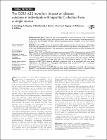| dc.contributor.author | Kelleher, Dermot | en |
| dc.contributor.author | Mc Kiernan, Susan | en |
| dc.date.accessioned | 2009-10-07T18:55:45Z | |
| dc.date.available | 2009-10-07T18:55:45Z | |
| dc.date.issued | 2005 | en |
| dc.date.submitted | 2005 | en |
| dc.identifier.citation | C Goulding, A Murphy, G MacDonald, S Barrett, J Crowe, J Hegarty, S McKiernan, D Kelleher, The CCR5-delta32 mutation: impact on disease outcome in individuals with hepatitis C infection from a single source, Gut, 54, 8, 2005, 1157, 1161 | en |
| dc.identifier.other | Y | en |
| dc.identifier.uri | http://hdl.handle.net/2262/33850 | |
| dc.description | PUBLISHED | en |
| dc.description.abstract | BACKGROUND AND AIMS: Chemokines are small polypeptides, a major function of which is lymphocyte recruitment and trafficking. The aim of this study was to assess the involvement of inherited variations in CCR2, CCR5, and the ligand RANTES in determining disease outcome in hepatitis C virus (HCV) infected individuals. METHODS: A total of 283 women, all exposed to HCV genotype 1b from a single donor, and including those who had spontaneously cleared the virus and those chronically infected, were genotyped for CCR2, CCR5, and RANTES polymorphisms. The frequencies of these polymorphisms were then compared with disease activity and severity. RESULTS: CCR5, CCR2, and RANTES genotypes were compared with HCV polymerase chain reaction (PCR) status, alanine aminotransferase levels, and liver histology. There was no significant relationship between CCR2 or RANTES polymorphisms and disease outcome or severity. However, CCR5delta32 heterozygotes were more likely to have spontaneous clearance of the virus than those without the mutation (42% PCR negative v 28.3% negative; p = 0.044, odds ratio 1.83 (95% confidence interval 1.1-3.6)). Among the subgroup of DRB1*03011 negative individuals, previously found to be associated with more severe inflammation, the difference in histological inflammatory score (CCR5WT/WT = 4.9 v CCR5delta32/WT = 3.53; p = 0.043) was significant. CONCLUSION: Heterozygosity for CCR5delta32 was shown to be significantly associated with spontaneous hepatitis C viral clearance and with significantly lower hepatic inflammatory scores in subgroups within this cohort. Both controls and the HCV population had similar heterozygosity frequencies. | en |
| dc.description.sponsorship | This research was sponsored by grants from the Higher Education Authority under the Programme for Research in Third Level Institutions, the Health Research Board, and the European Union (EU) Framework IV. | en |
| dc.format.extent | 1157 | en |
| dc.format.extent | 1161 | en |
| dc.format.mimetype | application/pdf | |
| dc.language.iso | en | en |
| dc.relation.ispartofseries | Gut | en |
| dc.relation.ispartofseries | 54 | en |
| dc.relation.ispartofseries | 8 | en |
| dc.rights | Y | en |
| dc.subject | hepatitis C virus, chemokine receptor 5, viral clearance, RANTES, hepatic inflammation | en |
| dc.title | The CCR5-delta32 mutation: impact on disease outcome in individuals with hepatitis C infection from a single source | en |
| dc.type | Journal Article | en |
| dc.type.supercollection | scholarly_publications | en |
| dc.type.supercollection | refereed_publications | en |
| dc.identifier.peoplefinderurl | http://people.tcd.ie/kellehdp | en |
| dc.identifier.peoplefinderurl | http://people.tcd.ie/smckiern | en |
| dc.identifier.rssinternalid | 29608 | en |
| dc.identifier.doi | http://dx.doi.org/10.1136/gut.2004.055699 | en |
| dc.identifier.rssuri | http://dx.doi.org/10.1136/gut.2004.055699 | |




